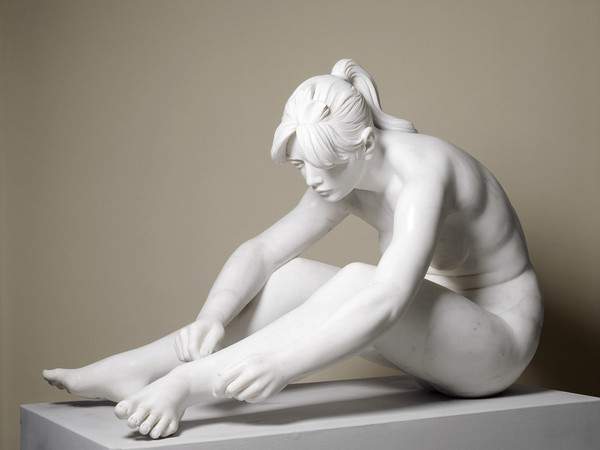In Vercelli, 120 works to mark 120 years since the birth of Francesco Messina
Three venues(ARCA, Palazzo Arcivescovile, former San Vittore Church), 120 works, not a few of significant size, to celebrate, 120 years after his birth, Francesco Messina (Linguaglossa, Catania 1900 - Milan 1995), certainly one of the greatest sculptors of the last century. Promoting this grand retrospective are the City and Archdiocese of Vercelli with the collaboration of the Messina Foundation and Nicola Loi Studio Copernico, Milan.
The three venues welcome large marbles, many bronzes and portraits of friends and colleagues - memorable, among many, those of Lucio Fontana, Salvatore Quasimodo, Riccardo Bacchelli (with monocle), Alfonso Gatto, Arturo Tosi, Eugenio D’Ors, while among the female figures, particularly dancers, the portrait of Carla Fracci, Luciana Savignano and Aida Accolla. There are also painted works of absolute fascination, Lia Ranza, Isabella Ostini and Vittoria Leone. Among the works in the ARCA, one section is devoted to horses, which immediately remind us of the image of the great dying horse modeled in 1966 for the Palazzo della Rai in Rome.
In the Archiepiscopal Palace and in the former church of San Vittore, works of a religious nature find their natural place (in particularly evocative settings, especially the seat of the bishop of Vercelli where the hall displays the chronotaxy of portraits of all the bishops who have belonged to the history of the diocese), such as one of the bronze sketches of the great statue of Pius XII (St. Peter in the Vatican) and that of St. Philip Neri, the naked and kneeling Job of 1933, with thehumble rope encircling his hips, or theAdam and Eve of 1956, fragile yet majestic in the majesty of their bodies, clutching each other with their questioning gaze turned into the distance. There are many other works with a religious character, such as Cardinal Schuster, the deposition mindful of the Pietà Rondanini, and the beautiful panels (sketch) in gilded bronze for the Saint Catherine placed on the terraces of Castel Sant’Angelo in Rome.
The exhibition aims to reveal once again the sculptural mastery of Francesco Messina, who was not coincidentally present at the Venice Biennials of 1922, 1928, 1930, 1932, 1942 (personal room, winner of the international sculpture prize), 1956 (personal room). Important solo exhibitions (the debut one was held at the Milan Gallery in 1929, presented by Carlo Carrà) and group exhibitions were dedicated to Messina on all continents.
“We are really pleased to be able to inaugurate and to be able to offer the citizenship an exhibition of such great value,” says Mayor Andrea Corsaro, “it is an exhibition with a significant visual impact, which will strike the public for its immediacy and beauty, and moreover it is a cultural event that will have positive repercussions on the fabric of the city.”
“Francesco Messina,” notes Sandro Parmiggiani, author of the essay in the catalog, “is placed in the Italian line of great 20th-century sculpture, which, as Antonio Paolucci writes, unravels from Wildt, through Arturo Martini, Marino Marini, Giacomo Manzù, Messina himself, to Giuliano Vangi. Salvatore Quasimodo, a lifelong friend, called him an ’Apollonian and meditative spirit.’ Messina grafted all his work on tradition, from Egyptian, Greco-Roman and Renaissance, reaching the nineteenth century and his contemporaries. In his work there is a fidelity to an ancient rigor, to its highest achievements, and in this also lies his modernity. This fascination with the works of the past can be read in watermarks in many of the sculptures in the exhibition, and it seems to us entirely exemplary what De Chirico wrote in 1938, in the presentation of his solo exhibition at the Galleria ’La Cometa’ in Rome: ’The sculptures of Francesco Messina, wherever they are, make one glad to look at them, they live with men and console them with their presence.’”
The exhibition is accompanied by a prestigious catalog-monograph in co-edition between Polistampa Florence and Studio Copernico Milan.
Along with Giacomo Manzù, Arturo Martini and Marino Marini, Francesco Messina is considered one of the greatest exponents of 20th-century figurative sculpture. Artistically born in the Genoese workshops, Messina began exhibiting his works at a very young age in the most prestigious international events where he was noted for “a simple and grandiose doing and for idealistic and classical procedure, capable of giving life to forms that remain as ideal images”(Carlo Carrà, 1929).
His career spans the entire twentieth century and is influenced by the greatest artists and writers of the twentieth century. His works include St. Catherine of Siena on the Castel Sant’Angelo riverfront, the Via Crucis in San Giovanni Rotondo, RAI’s famous Dying Horse, and the Monument to Pius XII in St. Peter’s Basilica.
The exhibition Francesco Messina. Prodigies of Beauty. 120 works 120 years after his birth is open from December 18, 2021 to February 27, 2022.
For all information you can call +39 3383473682 or send an email to mostre@gmail.com.
Pictured: Francesco Messina, Estate (Summertime) (1989; marble, 96 x 140 x 66 cm). Ph credit: Studio Copernico
 |
| In Vercelli, 120 works to mark 120 years since the birth of Francesco Messina |
Warning: the translation into English of the original Italian article was created using automatic tools. We undertake to review all articles, but we do not guarantee the total absence of inaccuracies in the translation due to the program. You can find the original by clicking on the ITA button. If you find any mistake,please contact us.





























